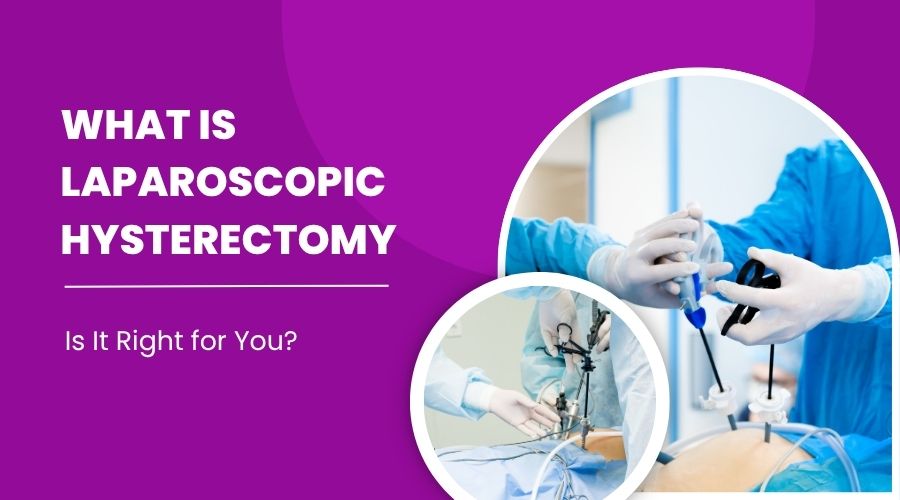
When it comes to women’s health, few procedures are as commonly discussed—and sometimes misunderstood—as hysterectomy. Traditionally performed through open abdominal surgery, a hysterectomy involves the removal of the uterus and is often recommended for various gynecological conditions. However, with advances in medical technology, laparoscopic hysterectomy has emerged as a minimally invasive alternative that offers faster recovery and less discomfort. But what exactly is it, and how do you know if it's the right choice for you?
Understanding Laparoscopic Hysterectomy
A laparoscopic hysterectomy is a surgical procedure to remove the uterus using small incisions and a specialized instrument called a laparoscope—a thin, lighted tube with a camera attached. This allows the surgeon to see inside the pelvis without making a large abdominal cut.
Unlike traditional abdominal hysterectomy, which typically requires a 5- to 7-inch incision and a longer recovery time, laparoscopic hysterectomy uses 3 to 4 small incisions (usually less than 1 cm each) in the abdomen. Through these incisions, surgical instruments and the laparoscope are inserted to perform the procedure.
Types of Laparoscopic Hysterectomy:
- Total laparoscopic hysterectomy (TLH): Removal of the uterus and cervix.
- Laparoscopic-assisted vaginal hysterectomy (LAVH): Partly done laparoscopically and completed through the vagina.
- Supracervical (subtotal) laparoscopic hysterectomy: Removal of the uterus while leaving the cervix intact.
The type recommended will depend on your specific condition, overall health, and personal preferences.
Why Is a Hysterectomy Performed?
Your gynecologist may recommend a hysterectomy for several medical reasons, including:
- Uterine fibroids that cause pain, bleeding, or other complications.
- Endometriosis, where the lining of the uterus grows outside the uterine cavity.
- Chronic pelvic pain or bleeding that doesn't respond to other treatments.
- Uterine prolapse, where the uterus slips from its normal position.
- Gynecologic cancers, including uterine, ovarian, or cervical cancer.
If you are experiencing any of these issues and other conservative treatments (such as medication or hormone therapy) haven’t worked, a hysterectomy may be the best option.
Benefits of Laparoscopic Hysterectomy
Compared to traditional open surgery, laparoscopic hysterectomy offers numerous advantages:
- Minimally invasive: Smaller incisions mean less trauma to the body.
- Faster recovery: Most patients return to normal activities within 2–4 weeks, compared to 6–8 weeks with open surgery.
- Less pain: Post-operative pain is significantly reduced.
- Reduced hospital stay: Many patients go home the same day or after one night.
- Minimal scarring: The small incisions lead to minimal visible scarring.
- Lower risk of infection and complications.
As a specialist in minimally invasive gynecologic surgery, Dr. Preeti Tandon emphasizes the importance of tailored care. Each patient’s body and medical history is different, and she works closely with you to determine the best surgical approach.
Is Laparoscopic Hysterectomy Right for You?
While laparoscopic hysterectomy is a safe and effective option for many women, it may not be suitable for everyone. Factors that affect candidacy include:
- Severity and complexity of the condition: Large fibroids, extensive endometriosis, or pelvic adhesions may require open surgery.
- Previous abdominal surgeries: Scar tissue from past procedures may make laparoscopy more difficult.
- Overall health status: Certain health conditions may influence surgical decisions.
- Surgeon’s expertise: Not all gynecologists are trained in advanced laparoscopic techniques. Choosing a specialist like Dr. Preeti Tandon, who has extensive experience in minimally invasive gynecologic surgery, ensures the best possible outcomes.
A thorough pre-operative evaluation, including pelvic exams, imaging, and medical history, is essential to determine if this approach is right for you.
What to Expect Before and After the Procedure
Before the surgery, you’ll undergo routine preoperative tests and receive instructions on preparing for the procedure. The operation typically takes between 1 to 3 hours, and most patients can return home the same day.
Recovery includes some mild cramping, light vaginal bleeding, and fatigue. However, most women experience a significant improvement in symptoms within a few weeks. You’ll be advised to avoid heavy lifting, strenuous exercise, and sexual activity for a period recommended by your doctor.
A laparoscopic hysterectomy is a transformative option for women struggling with painful or life-disrupting gynecologic conditions. It combines the effectiveness of traditional surgery with the benefits of modern minimally invasive techniques.
At Dr. Preeti Tandon’s clinic, we are committed to helping you understand your options and guiding you through every step of your treatment journey. If you’re considering a hysterectomy or have questions about your gynecologic health, schedule a consultation today. Together, we’ll find the safest, most effective path to restore your well-being and peace of mind.



